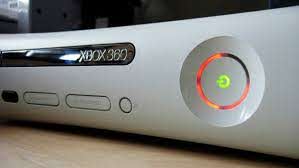Worse than the current Nintendo Switch Joy-Con Drift issues, and way more publicized (perhaps because the failure rate was much higher) than the PlayStation 3’s Yellow Light of death. The infamous Red Ring of Death, which plagued the Xbox 360, victimized most of us who got a launch system.
The estimated rate of failure for the early Xbox 360 units was as high as 54%. Personally, I think it is much higher. Out five friends that I knew, that had an early version of the system, all 5 of them had the Red Ring of Death issue happen to them (myself included).
The specific reasoning for why the console dooming flaw occured remains a bit of a mystery, but it is generally accepted that hairline cracks developed over time and use in the solder between the GPU and the mainboard, as a by product of excessive heat.
For those of us who adopted the Xbox 360 early, the experience of powerlessly staring at the 360, as its ring sections turned from green to Red (3 out of the 4 sections would start flashing red) was traumatizing.
It was so traumatizing, that I still routinely touch my PlayStation 4 to feel if it is overheating, and I unplug my Xbox One every night because for some reason, even while “off”, as long as it is connected to an electric socket the console remains on “standby” mode, and can get warm.
A massive new article from Edge Magazine sheds more life into the infamous console flaw. As with all hardware companies, Microsoft at first denied that there was a systemic issue, or a design flaw that was causing the console to fail.
Nintendo has taken a similar approach with its faulty Joy-Cons by refusing to admit that, indeed, there is a design flaw that is causing to the joysticks on the Joy-Cons to drift. So, in retrospective, Microsoft on 2007 approached the situation as well as it could have given the circumstances. The company had struck gold with great sales of its sophomore system, and were in a good place, but all could have fallen apart given the devastating nature of the Xbox 360’s flaw.

Edge Magazine, at the time (2007), consulted Diarmid Andrews, director of console repair firm GT Electronics, in order to get to the bottom of the Red Ring of Death issue.
“The CPU has a good heat sink and it’s fine, [but] the DVD-ROM sits right back on the GPU and the heat sink is really quite small. It could use a fan. The GPU is sitting on 400 little balls of solder, and that’s the connection to the main board. If even one of those balls gets a crack, or gets loose, you’ll get three red lights.”
It took Microsoft awhile to replace the original GPU chip with a smaller, more power efficient chip, but once they did, the issues were resolved.
However, things weren’t rosy before then, and Microsoft lost over a billion dollars in their groundbreaking 3-year warranty program which quickly fixed faulty consoles free of charge to its customer base. In 2015, Peter Moore (The Xbox Head during that time), would explain just how costly that entire venture ended up being for Microsoft at the time.
“We couldn’t actually figure out what was going on… I remember going to Robbie Bach, my boss, and saying, ‘I think we could have a billion-dollar problem here’. We knew it was heat-related. There were all kinds of fixes. I remember people putting wet towels around the box.”
“Steve (Balmer, Microsoft CEO at the time) looked at me and said, ‘What have we got to do?’ I said, ‘We’ve got to take them all back, and we’ve got to do this in a first-class way’. He said, ‘What’s it going to cost?’ I remember taking a deep breath, looking at Robbie, and saying, ‘We think it’s $1.15bn, Steve’. He said, ‘Do it’. There was no hesitation.”- Peter Moore
Microsoft handled the situation like a true champion, and to be honest, I don’t know that Nintendo, or Sony might have been able to survive such a billion dollar hit in the way that Microsoft did at the time, as their pockets aren’t nearly as deep.
Microsoft had to juggle a lot of issues then with 3rd parties, lawyers, repair centers, and retailers. The company came through with flying colors and eventually fixed the issue on the original design. Microsoft lost a billion dollars then, but saved a growing brand that today remains a strong player, and continues to grow through its Xbox Game Pass service.
As both Sony and Microsoft prepare to release their newest consoles in a few weeks, the Red Ring of Death remains a scary tale about how early hardware can fail under stress. New consoles undergo testing, but it is hard to say how they will perform under different settings, and stress points caused by different games, until the systems are finally out in the hands of gamers for a prolonged period of time.
Thankfully, it seems that both companies have invested money, and console space (within the console) this time around in the cooling solutions for both next-gen machines.
